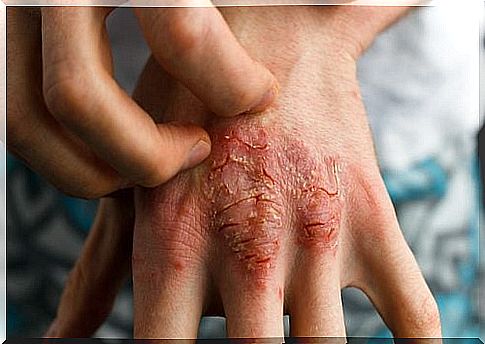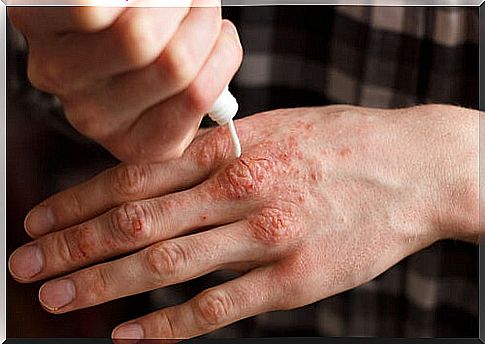Treatment Of Psoriasis
The treatment of psoriasis combats the symptoms by combining different therapies.

Treatment of psoriasis (psoriasis) focuses on the symptoms and depends on the clinical situation in the individual case.
There is no standard treatment, but there are several ways to keep the disease under control and minimize it.
Common symptoms are:
- inflammation
- Reddening of the skin
- Peeling of the skin
- itching
The different types of treatment for psoriasis are:
- local therapy,
- Phototherapy and photochemotherapy,
- medicines to be taken orally or
- biological therapies.
Local therapies
These initial treatments are used for the majority of patients. They consist in applying ointments and creams to the external lesions on the skin.
The most common local medicines used to fight psoriasis include:
- Vitamin D analogues
- typical cortisones
- Keratolytics
- local retinoids
- Tars
Vitamin D analogues: calcitriol, calcipotriol or tacalcitol
The most efficient of these is calcipotriol. The clinical effect of these analogues occurs more slowly than the more potent cortisones, but has a higher degree of safety. Therefore, they are used for long-term treatment.
It is recommended to combine them with topical cortisone as this combination is more effective than either drug alone.
Despite their high level of safety, the vitamin D analogues still have a clear side effect: there is a possibility of skin irritation in the affected regions. Therefore, exposure to direct sunlight should be avoided after the medication has been applied.
Typical cortisones
This group of drugs is primarily used to lighten the flakes of skin and reduce inflammation. They are used in low doses in sensitive areas (face, groin), high doses on the scalp, areas with thicker encrustations, as well as on hands and feet.

Experts recommend using the high-dose cortisones at the beginning of treatment and then continuing with the lower-dose ones. It is also advisable to combine them with other therapies, such as vitamin D analogues.
Cortisone should be used with care, as side effects can occur locally and in some cases affect the nervous system.
In the group of local side effects, the following occur:
- Reduction in skin thickness
- Lightening of the skin by inhibiting pigment cells
- Oral rose
- small bleeding into the skin
Nervous system disorders are rare but serious. Inhibitions of the hypothalamic-pituitary axis or Cushing’s syndrome can occur, among other things.
To avoid them, it is recommended to use cortisones no more than twice a day. One must also keep in mind that there is a risk of relapse if treatment is stopped suddenly.
Acetylsalicylic acid (aspirin)
The use of acetylsalicylic acid is limited to removing the dandruff; it also favors tissue renewal. In addition, it makes the drugs more effective because they are more easily absorbed. Therefore, the drug should be viewed as an accompanying treatment.
Local retinoids
These are analogues of vitamin A. Tazarotene is the only drug available on the market for the treatment of psoriasis. It is used in combination with cortisone.
It can cause skin irritation, which is why it should not be used on scabs on the face or groin. Like all analogues to vitamin A, it is light-sensitive and harmful to fertility. Pregnant women should therefore refrain from taking it.
Tars
This is the oldest form of treatment for psoriasis. They are made from coal tar. Even if the smell is sometimes offensive and the clothes get stained easily, they are occasionally used on incrustations.
They are also sensitive to light. You should avoid direct sunlight after use.
Photo therapy and photo chemotherapy
This type of treatment is used when the local therapy does not have the desired effect or the incrustations are very thick.
- For phototherapy belonging UVB rays (broadband rays are more effective and cause less burns). They are used in conjunction with tazarotene, vitamin D analogues, or treatments for the nervous system.
- Photo-chemotherapy : It is also known under the term PUVA. First of all, topical or oral drugs are used to combat psoriasis, which have a light-sensitive effect. This is then combined with exposure to UVA rays. It is an alternative treatment for those patients on whom UVB rays are ineffective. PUVA is more efficient and the effects last longer. However, it has been linked to skin cancers and melanoma.

Oral medications for the nervous system
Treatment of the nervous system occurs when no other therapy has worked. The treatment is carried out by:
- Suppression of the immune system
- Retinoids
Suppression of the immune system
It is in this group that the drug methotrexate is most often used. It is mainly used for long-term treatment. However, because of the side effects, the patient must be monitored. Pregnancy should also be avoided for up to three months after treatment.
Another drug used to suppress the immune system is oral ciclosporin. This works just as well or even a little better than methotrexate. However, it is toxic to the kidneys and can trigger high blood pressure. Observation of the patient is therefore necessary. It is therefore recommended for temporary treatment of short duration.
Retinoids
The drug acitretin (analogue of vitamin A) can be used as an alternative for patients with pustular psoriasis. It is also indicated for people with impaired immune systems who cannot use immunosuppressive drugs.
It can also be combined with UVB or UVA radiation. However, the effect is less than that of cyclosporine. The kidney-damaging side effect can persist for up to two years after treatment.
Biological therapies to treat psoriasis
These drugs are only withheld from patients who cannot tolerate UVA radiation or oral treatments of the nervous system. Ustekinomab is a biological drug whose only application is psoriasis. It therefore requires patient observation to control side effects, as long-term safety has not been researched.









